Norm of air humidity in an apartment: methods of measurement + tips for normalization
The health of its inhabitants largely depends on how much water vapor is contained in the air of a home.For good health, it is important that the humidity level in the apartment corresponds to standard indicators. However, if enough attention is paid to the temperature regime, then the saturation of the atmosphere with moisture is often forgotten, isn’t it?
We suggest you figure out what the standard air humidity in an apartment is, what its significance is for different rooms, and how to correctly measure this indicator. Having determined the degree of humidity, measures should be taken to reduce or increase the water content in the room atmosphere. Effective methods for normalizing the microclimate are described in the article.
The content of the article:
What is the humidity standard?
There is always water vapor in the atmosphere of our planet. To measure them, the concept of absolute humidity is used. It denotes the mass fraction of water content in one cubic meter of gas mixture. At an ambient temperature of 0ºС this value corresponds to 5 g/m3.
As the air temperature rises, water will evaporate faster, causing the percentage of moisture entering the atmosphere to increase.
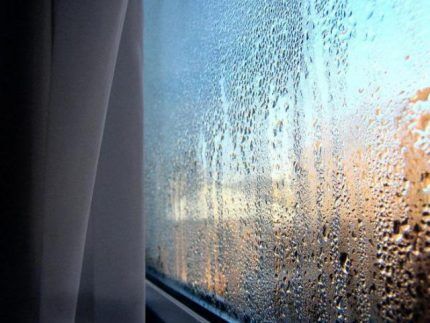
The term relative humidity refers to the amount of moisture in the air at a certain temperature compared to the maximum amount of water vapor that could saturate the atmosphere at that same temperature.
When talking about the norm of humidity in a living space, we mean precisely this relative value, expressed as a percentage.
The effect of humidity on well-being
It has long been noted that people are extremely sensitive to the content of water vapor in their homes. With low or high moisture content in the air, apartment dwellers feel uncomfortable. The most pronounced symptoms are weakness, fatigue, headache, decreased immunity.

Dry microclimate promotes the accumulation of static electricity, which causes the accumulation of tiny dust particles in the air. This is an excellent environment for bacteria and microscopic organisms that cause various diseases to thrive.
In such rooms, people often experience dry skin, which leads to dermatitis, brittle hair, and the appearance of early wrinkles. Drying of the mucous membranes contributes to the development of frequent colds, as well as eye diseases.
Due to the slowdown in blood circulation, the load on the heart increases, which can lead to increased blood pressure and ailments of the cardiovascular system.
Humid microclimate in the house is no less dangerous. In this case, favorable conditions are created for bacteria to flourish, appearance of black mold, fungi that form colonies on wet walls.
The harmful substances released by these single-celled creatures can lead not only to the development of allergies, but also to acute poisoning. Its first symptoms are weakness and dizziness.

A long stay in a damp room threatens the development of all kinds of diseases - from common acute respiratory infections to rheumatism and tuberculosis. With high humidity in living spaces, there is a lack of oxygen, which increases the load on the heart and leads to diseases of this important organ.
It is especially dangerous if the increased level of water vapor is combined with high air temperature, which can trigger heatstroke or even a heart attack.
Recommended standards for an apartment
Since air humidity is an extremely important criterion for a comfortable living environment, there are special regulatory documents that regulate its importance.
GOST 30494-96 indicates indicators of seasonal moisture content in the housing stock: for summer, the limits of optimal air humidity are determined in the range of 30-60%, for winter - 30-45%.

There is also a corresponding SNiP, according to which the norm of 40-60% applies for any time of the year. For humid areas, 65% is allowed, and for very humid areas - 75%.
It should be noted that the standards are designed for construction organizations; most people define air with 30 percent humidity as dry.
Here are specific recommendations for water vapor content:
- in the bedroom;
- in the nursery;
- in the living room;
- in the office;
- in the kitchen and bathroom.
Bedroom is of great importance, since healthy sleep largely determines a person’s condition and helps maintain immunity. The ideal humidity level for this room is 40-55%.
Experts recommend keeping the window in the bedroom always half open, which promotes natural regulation of humidity and hardening. An alternative option is to install window ventilator.

Children's room. Here, the normal level of water vapor content is of paramount importance, since a fragile body is more sensitive to heat and cold, and is also more susceptible to infections. The optimal figure is 50-60%.
Insufficiently humid air dries out the nasopharynx, opening the way for colds, and is also harmful to the skin, causing peeling and even dermatitis. It should be borne in mind that the temperature in the nursery should not exceed 24ºС.
Living room. As a rule, the most spacious room in the apartment is allocated for this room, where the family spends several hours every day. The most comfortable humidity level here can be considered 40-50%.
This standard ensures the well-being of people, while at the same time guaranteeing the excellent condition of electronic devices and expensive furniture, which is often installed in the living room.
Study/library. Here a lower moisture level of 30-40% is acceptable.This is due to the fact that books and documents are usually stored in these rooms, as well as office equipment, which can be damaged by an excessive amount of water vapor in the atmosphere.
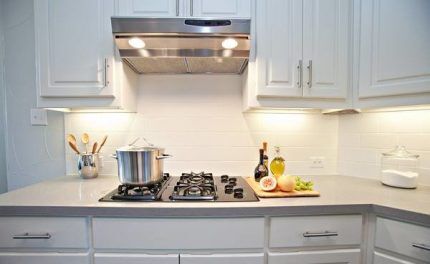
Kitchen and bath. The premises are characterized by increased temperature and humidity conditions, which negatively affects people’s health, the condition of equipment and furniture. It is important not to forget about these zones - to bring the degree of water vapor content to 45-50%, use exhaust fans.
Signs of a “failure” of the humidity regime
By being observant, it is easy to conclude what microclimate is typical for the room.
The following features indicate dry air:
- the soil in pots with indoor flowers quickly dries out and becomes covered with cracks;
- things and objects in the room are quickly electrified by static electricity;
- wet laundry dries in a couple of hours, but it is difficult to iron;
- Even with constant cleaning, the smell of dust can be felt in the air.
One of the first signs of dry air is the drying out of the edges of the leaves of indoor flowers and their wilting.
Many factors indicate an increased proportion of water vapor in the room. Such rooms smell musty, and clothes and bedding are constantly damp.
The water in the flower trays usually stagnates, and the soil in the pots becomes covered with a moldy white coating.
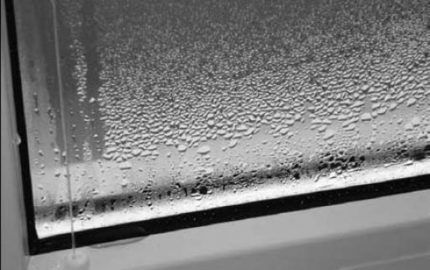
It is worth paying attention to the quickly getting wet salt in the open salt shaker, swollen and poorly closing doors.
A lot of trouble can be caused by wallpaper coming off the walls, mold and mildew stains that appear on horizontal and vertical surfaces.
Methods for determining humidity
In order to determine the microclimate of the room, you can use special devices or improvised means. Let's look at a few common methods
Method No. 1 - natural materials
An ordinary fir cone can be a faithful assistant. It should be brought into the room and placed away from heat sources.
If the scales open, the room has a dry microclimate. If the content of water vapor in the air is high, the bud will remain tightly compressed.

A more complex method is a homemade device made from a spruce branch, which allows you to monitor the dynamics of water vapor content in the room.
A peeled spruce stick 21-30 cm long is fixed to the board from the cut side, while the other end remains free. As the moisture level increases, it will drop down, which can be checked by recording the readings with a pencil.
Method number 2 - a glass of water
It is enough to do a simple experiment: cool a glass glass of water in the refrigerator to a temperature of 3-5ºC.
After removing the container from the refrigerator, you should observe it for 5-10 minutes:
- if condensation flows down in large droplets, there is excessive humidity in the room;
- glass walls dry out instantly - there is a lack of water vapor in the air;
- the container remains foggy - the humidity is close to ideal.
As in the previous case, this method is quite approximate. However, it allows you to determine not only increased and decreased levels of water vapor, but also comfortable humidity.
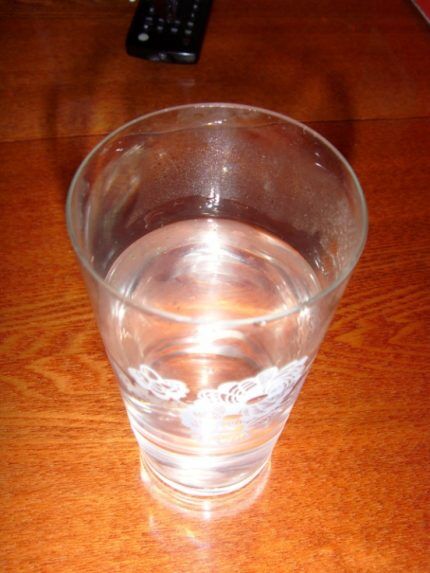
Method No. 3 - Assmann psychrometer
This method requires a special device consisting of two alcohol thermometers: one regular, and the other moistened with damp cambric tape.
Readings should be taken from two devices, which will differ due to the influence of the environment, primarily the moisture content in the atmosphere.

From the first value, you need to subtract the second, after which in the Assmann table, find the dry device indicator in the vertical column, and the temperature difference in the horizontal column. The number at the intersection of the lines indicates the desired moisture level in the room.
At home, you can get by with one room thermometer. To do this, you first need to record the temperature in normal mode, and then wrap the device head with a damp cloth or swab.
After 5-10 minutes, you can take the result, then calculate the difference between the readings and insert the data into the table.
Method No. 3 - accurate hygrometer readings
The most convenient way to determine the humidity of the atmosphere is with a hygrometer - a special device designed for this purpose.
There are many varieties of such devices operating on different principles: weight, film, hair, condensation, electrolytic, ceramic.

Electronic hygrometers have become especially widespread, the functioning of which can be based on different methods of taking readings.
Among them, we note the following categories of devices:
- optoelectronic – with measurement using a cooled mirror;
- resistive using the effect of changing the conductivity of certain types of salts/polymers;
- capacitive, where the change in capacitance of the capacitor is taken into account;
- devices based on determining air conductivity.
Hygrometer models can be stationary or mobile. Devices from the last category can be moved from one room to another.
For more information on different humidity measuring instruments and tips for using them, see this article.
Tips for normalizing the microclimate
To maintain the proper microclimate in the apartment, you can use the recommendations of specialists.
So, to combat excessively dry air, the following are used:
- traditional methods;
- special devices.
A decorative fountain, a spacious aquarium with colorful fish or flowerpots with house flowers are not only spectacular interior decorations, but also an effective way to maintain normal humidity in the atmosphere of a living space, for example, a living room.
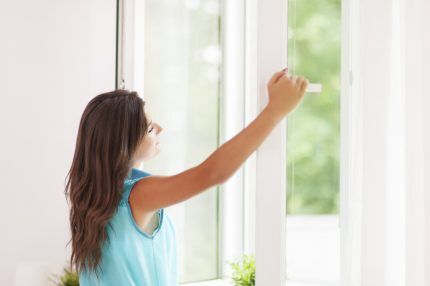
A simple but quite effective remedy is to place containers of water near heating appliances or on radiators. Liquid must be added to the vessels as it evaporates.
Alternatively, wet towels, napkins or other pieces of fabric are thrown over the batteries. You can also hang washed clothes in the room to dry.
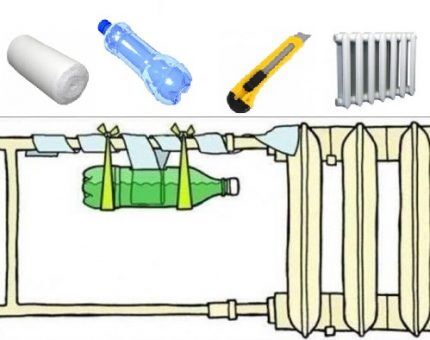
Special solutions will help to radically solve the problem with humidity levels humidifying devices, whose work is based on various methods:
- mechanical humidifier with a fan, quite noisy, but not very efficient - 50-61%;
- steam humidifier, functioning similarly to an electric kettle. It is capable of increasing the vapor content rate by 60%;
- ultrasonic humidifier, the method of operation of which is based on spraying water droplets using a piezoelectric emitter. The device, which quickly increases humidity to 100%, is characterized by silent and safe operation.
The first two options are distinguished by their affordable cost and the possibility of using tap water, while for the work of a more expensive ultrasonic device distilled liquid is required.
To reduce the degree of air humidity, you can also use either traditional methods or resort to the help of modern devices.
In a damp room, care should be taken to let in as much sunlight as possible. There is no need to shade the windows with curtains, because the rays of the sun perfectly dry the air. Housing should be regularly ventilated to bring in fresh air.
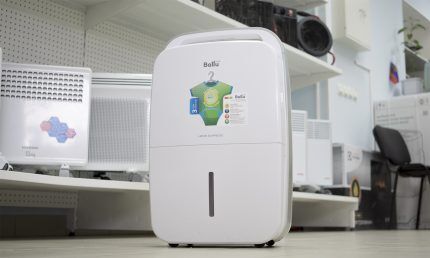
Can be installed in all rooms forced exhaust ventilation, and in the kitchen it is better to cook by turning on a powerful hood. If an air conditioner is installed in the apartment, it is important to choose the optimal operating mode.
If the air temperature is insufficient, you should think about using additional heating devices. When carrying out construction and finishing work, it is advisable to prefer natural materials that absorb moisture well.
The best results can be achieved using special devices.
Two categories of devices are most often used:
- plastic containersfilled with adsorbents - substances that actively absorb water vapor; it is important not to forget to change the filler as it gets wet;
- household dehumidifiers air, the operation of which is usually based on the principle of condensation of atmospheric water vapor on a plate whose temperature is below the dew point.
To normalize the indoor microclimate, it is important to pay attention to windows and window treatments. It is best to install modern double-glazed windows made using new technologies that guarantee air circulation.
Conclusions and useful video on the topic
A video with a specialist talking about what kind of troubles you can expect from excessively dry air in living spaces:
The following video will help you get information about the different types of instruments designed to measure humidity levels:
The video clearly shows 5 easy ways to increase indoor air humidification:
Human health and ability to work largely depend on maintaining recommended indoor humidity standards. It is important to steadily monitor this indicator, using traditional methods, or better yet, special devices.
At the first deviations, you need to think about what to do to normalize the microclimate in the apartment. In some cases, you can do it at home, but devices designed for this purpose will provide more effective help.
Share with readers your methods of maintaining normal humidity in the apartment. Please leave comments, ask questions about the topic of the article and participate in discussions - the feedback form is located below.




A lot depends on the region of residence. Here in the Far East we experience huge differences in humidity - in the summer it is 100% and often very hot at the same time. Mold in the bathroom is inevitable. Air conditioning doesn't help much in this regard. By the end of winter, with heating, everything dries out more or less. How to deal with excess moisture? Leave her for Crimea, maybe?
Air dehumidifiers are specially designed for such difficult cases as yours. There are also air conditioners with this function, but it is more efficient to buy a specialized device. They are sold in almost any company that deals with air conditioners; they cost 10-20 thousand rubles, depending on the intensity of dehumidification and the presence of additional functions.
I determine the humidity level using a glass of water - the easiest and most reliable way. Due to the climate, there is usually a lack of humidity in the house.Previously, we solved this problem by placing containers of water everywhere, but since the baby was born, it was decided to buy a humidifier. We took a simple and inexpensive model, pour water into it, and during the day the device maintains normal humidity in the children's room.
I never thought much about the level of humidity in the apartment, but I noticed that with the arrival of the heating season, I began to feel not very good. Especially if the batteries are turned on at full power. This is when you need a humidifier.